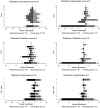The MedXFit-study - CrossFit as a workplace health intervention: a one-year, prospective, controlled, longitudinal, intervention study
- PMID: 38450146
- PMCID: PMC10915069
- DOI: 10.3389/fpubh.2024.1304721
The MedXFit-study - CrossFit as a workplace health intervention: a one-year, prospective, controlled, longitudinal, intervention study
Abstract
Introduction: Workplace health interventions aim to motivate employees toward healthy behaviors to improve fitness and health in the long-term. We investigated whether CrossFit® is an effective training concept to achieve these goals in inactive employees with sedentary occupations.
Methods: The study followed a prospective, controlled intervention design. Employees were invited to participate in intervention group (IG) or control group (CG) on their own preferences. Inclusion criteria were a predominantly sedentary occupation and execution of less than two muscle and/or mobility enhancing training sessions per week at the time of enrolling. The IG did at least two times a week a CrossFit training of 1 h. Mobility, strength, well-being, and back-issues were measured at the beginning, after 6, and 12 months. Participants in the CG were free to choose any other activities offered at the same time (e.g., circuit training, meditation, full body stability training). Adherence, respectively, behavioral change and maintenance qualities were evaluated based on the COM-B system and presence of behavior maintenance motives.
Results: 89 employees were enrolled into the trial, from where 21 dropped out due to external factors (24%). From the remaining participants, 10 out of 39 (26%) in the IG and 1 out of 29 (4%) in the CG stopped for intrinsic reasons, leading to a non-adherence to the intervention of 22 percentage points. Motivation for behavioral change and maintenance in the IG was primarily driven by enhanced physical and psychological capability. Development of physical capability was evident by significant improvements (p < 0.001) in the IG compared to the CG for mobility (d = 3.3), maximal isometric strength (min. d = 1.7, max. d = 2.5), as well as reduction in pain intensity (p = 0.003, r = 0.4) and frequency (p = 0.009, r = 0.35) after 12 months. Significant improvements between the 6-month and the 12-month measurement in mobility and 6 out of 8 strength measures within the IG indicated the effectiveness of CrossFit beyond the beginner phase.
Conclusion: CrossFit is a motivating training concept that led to long-term health and fitness improvements in inactive employees doing sedentary work and should be given greater consideration in workplace health promotion.
Keywords: back pain; behavioral change and maintenance; exercise; functional fitness; military; mobility; strength; well-being.
Copyright © 2024 Brandt, Heinz, Klaaßen, Limbara, Mörsdorf, Schinköthe and Schmidt.
Conflict of interest statement
The authors declare that the research was conducted in the absence of any commercial or financial relationships that could be construed as a potential conflict of interest.
Figures







Similar articles
-
MedXFit-Effects of 6 months CrossFit® in sedentary and inactive employees: A prospective, controlled, longitudinal, intervention study.Health Sci Rep. 2022 Aug 7;5(5):e749. doi: 10.1002/hsr2.749. eCollection 2022 Sep. Health Sci Rep. 2022. PMID: 35949685 Free PMC article.
-
Resistance exercise snacks improve muscle mass in female university employees: a prospective, controlled, intervention pilot-study.Front Public Health. 2024 Feb 6;12:1347825. doi: 10.3389/fpubh.2024.1347825. eCollection 2024. Front Public Health. 2024. PMID: 38379679 Free PMC article.
-
Health-Promoting Effects of a Concurrent Workplace Training Program in Inactive Office Workers (HealPWorkers): A Randomized Controlled Study.Am J Health Promot. 2020 May;34(4):376-386. doi: 10.1177/0890117119899781. Epub 2020 Jan 17. Am J Health Promot. 2020. PMID: 31950855 Clinical Trial.
-
Interventions outside the workplace for reducing sedentary behaviour in adults under 60 years of age.Cochrane Database Syst Rev. 2020 Jul 17;7(7):CD012554. doi: 10.1002/14651858.CD012554.pub2. Cochrane Database Syst Rev. 2020. PMID: 32678471 Free PMC article.
-
Workplace interventions for increasing standing or walking for decreasing musculoskeletal symptoms in sedentary workers.Cochrane Database Syst Rev. 2019 Nov 17;2019(11):CD012487. doi: 10.1002/14651858.CD012487.pub2. Cochrane Database Syst Rev. 2019. PMID: 31742666 Free PMC article.
Cited by
-
Acute physiological responses and performance determinants in Hyrox© - a new running-focused high intensity functional fitness trend.Front Physiol. 2025 Mar 31;16:1519240. doi: 10.3389/fphys.2025.1519240. eCollection 2025. Front Physiol. 2025. PMID: 40230601 Free PMC article.
-
Factors for adherence to a physical activity promotion program in the workplace: a systematic review.BMC Public Health. 2025 May 17;25(1):1827. doi: 10.1186/s12889-025-22775-4. BMC Public Health. 2025. PMID: 40382548 Free PMC article.
References
-
- World Health Organization . Global action plan for the prevention and control of noncommunicable diseases 2013–2020. Geneva: World Health Organization; (2013). 103 p.
-
- Finger JD, Mensink G, Lange C, Manz K. Arbeitsbezogene körperliche Aktivität bei Erwachsenen in Deutschland. J Health Monit. (2017) 2:29–36. doi: 10.17886/RKI-GBE-2017-026 - DOI
-
- World Health Organization . Preventing noncommunicable diseases in the workplace through diet and physical activity. Geneva: World Health Organization. Geneva: World Health Organization; (2008).
Publication types
MeSH terms
LinkOut - more resources
Full Text Sources

